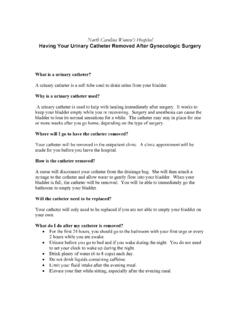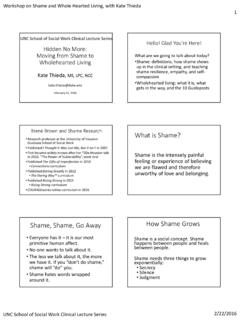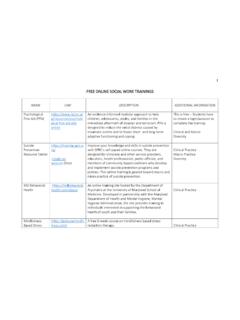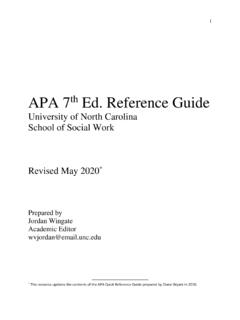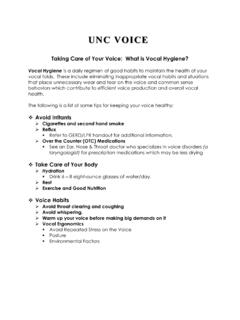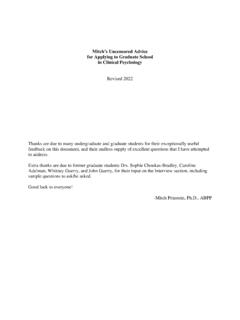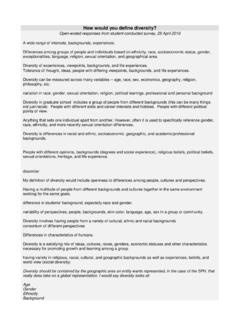Transcription of ISNCSCI / ASIA Examination & Cases - UNC School of Medicine
1 UNC SCI Conference: November 7-8, 20141 ISNCSCI / ASIA Examination & CasesHeather Walker, MDSCI Medical DirectorUNC Department of PM&RObjectives Be familiar with how the ISNCSCI /ASIA exam is performed International Standards for the Neurologic Classification of Spinal Cord Injury American Spinal Injury Association Be able to define/determine the following: Sensory level Motor level Neurological level of injury Completeness of injury AIS Classification Be able to determine ASIA classification using practice casesUNC SCI Conference: November 7-8, 20142 ASIA Standards Frankel Classification 1969 Frankel A, B, C, D, E ASIA Standards 1982 Modified from the Frankel Scale, further defined subgroups ASIA Revision 1989 Standardization of sensory anatomical landmarks; sacral sparing incorporated ASIA Impairment Scale 1992 FIM incorporated, PP/LT tested separately, motor level defined as 3/5 with 5/5 above.
2 Revisions 1996 ASIA C vs. D clarified; motor level determined by sensory level in areas unable to be tested (C2-4, T2-L1) Revisions 2000 ASIA C/D required to have either voluntary anal contraction OR sensory sacral sparing w/ sparing of motor function more than three levelsbelow motor level; FIM revisions!!! 2011 Deep anal sensation replaced with pressure Classification as C1 AIS X for patient with impaired/absent sensation at C2 If LT/PP sensation present at S4/5 don t have to test deep anal sensation (but your finger is there anyway, so you might as well) ZPP defined as the dermatomes and myotomes caudal to the sensory and motor levels (rather than NLI) on each side of the body that remain partially innervated in complete SCI Emphasis on calling it the ISNCSCI exam (International Standards for Neurological Classification of SCI)UNC SCI Conference: November 7-8, 20143 ASIA Examination Sensory level Motor level Neurological level of injury (NLI) Complete vs.
3 Incomplete injury Sacral sparing Zone of Partial Preservation (complete injuries)Sensory Level 28key dermatomes Test light touch and pinprick Face is used as control. Three point scale: 0 = absent 1 = impaired 2 = normal NT = not testedUNC SCI Conference: November 7-8, 20144 Light Touch Sensory Scoring Use cotton tip applicator Stroke across skin moving over a distance that does not exceed 1 cm For C6-C8 use dorsal surface of proximal phalanx Chest and abdomen points should be tested in the midclavicular Sensory Scoring Clean safety pin Use consistent pressure in each dermatome Poke one time only, not repeatedPop quiz! You test the C6 dermatome and patient says It feels sharp, but not as sharp as my face . What score do you assign that dermatome?UNC SCI Conference: November 7-8, 20145 Sensory TractsPatient feeling PP but unable to differentiate sharp and dull is simply sensing pressure PP sensation is = Dorsal columnsPP = Spinothalamic tractsSensory Testing perianal area S4/5 dermatome represents the most caudal aspect of the spinal cord S4/5 is tested for both PP and LT Deep anal pressure: on digital rectal exam patient is asked to report sensory awareness.
4 Recorded as present or absent .UNC SCI Conference: November 7-8, 20146 Determining sensory Determined for right side and left side Defined as the level where sensory function is normal on both sides of the body Lowest level where you have 2 s with all above levels being 2 s Sensory Testing Pitfalls Inappropriately scoring PP as impaired when it should be absent Unable to differentiate between sharp and dull edges = ABSENT!! Something about C4 Bib???UNC SCI Conference: November 7-8, 20147 Motor Examination 10key muscle groups Other muscles may be clinically important but do not contribute to motor scores Examine in rostral to caudal sequence (Don t Skip Around!) Tested in supineposition Necessary during acute period, allows for comparison later on. 6 point scale (0-5) Only whole numbers, no plus/minus (for research purposes)Motor Exam 1:Muscle twitch 2:Full active ROM with gravity eliminated 3:Full active ROM against gravity 4:Able to generate some resistance 5:Normal strengthUNC SCI Conference: November 7-8, 20148 Motor ExaminationUpper Extremities: C5 = Elbow Flexors C6 = Wrist Extensors C7 = Elbow Extensors C8 = Finger Flexors T1 = Finger AbductorsLower Extremities: L2 =Hip Flexors L3 = Knee Extensors L4 = Ankle Dorsiflexors L5 = Long Toe Extensors S1 = Ankle PlantarflexorsMotor Testing Test each of the ten key muscles Record numeric values only (for research and test-taking purposes).
5 Voluntary anal contraction: contraction of EAS around examiners finger; graded as present or absent UNC SCI Conference: November 7-8, 20149 Motor Testing Fine points If only minimal movement in muscle group palpate over muscle Pain and deconditioning may cause patient to grade 4/5; can grade this as 5* Score NT if patient not fully testable due to pain, spasticity, uncontrolled clonus, fractureMotor Testing Fine points Contractures: What do we do???NT if contracture limits > 50% ROMUNC SCI Conference: November 7-8, 201410 Motor Examination Key muscles are given a single level on ASIA (elbow flexors = C5) for simplification. Muscles generally innervated by at least two roots (biceps = C5,6).Motor Examination If muscle has onlyrostral root intact (C5 for elbow flexors) will likely have 3/5 strength. If both C5,6 intact will have 5/5 strength. This is important for determining motor level!
6 !!UNC SCI Conference: November 7-8, 201411 Motor Score Level at which strength is at least 3/5 with all levels above being 5/5 Scored for each side, overall score is last normal for both. Left = C6 Right = C7 Overall motor score = C6 What if you can t test the motor level?Sensory Level T8 UNC SCI Conference: November 7-8, 201412 Motor Level 1996 revision: Sensory level is in a region that cannot be tested (C2-4, T2-L1, S3-5) Motor level is designated as being the same as the sensory level. If can t test motor, then motor level is same as sensory Level T8 Motor Level T8 UNC SCI Conference: November 7-8, 201413 Neurological Level of Injury The most caudal (lowest) level at which both motor and sensory modalities are intact on both sides of the body. Motor >3/5 w/ levels above being 5/5 Sensory intact bilaterally for LT and PP with all sensation above intact If there is no key muscle for a segment that has sensory intact (C2-4, T2-L1, S3-5), the sensory level defines the motor level and the NLIC omplete vs.
7 Incomplete Complete = NO sacral sparing NOON sign Incomplete = ANY sacral sparingUNC SCI Conference: November 7-8, 201414 Sacral touch sensation at S4 at S4 anal anal contractionZone of Partial Preservation All segments below NLI with presevation of sensory or motor findings in complete SCI Conference: November 7-8, 201415 ASIA Impairment Scale Classification AIS A= Motor and Sensory Complete No motor or sensory function preserved in sacral segments (S4/5) AIS B= Sensory Incomplete Sensory but no motor below the NLI, and includes sacral segments S4/5 AIS C= Motor Incomplete Motor function preserved below NLI, and more than halfof the muscles have grade <3/5 AIS D= Motor Incomplete Motor function preserved below NLI, and at least halfof the muscles have grade >3/5 AIS E= Normal; motor and sensory function are Incomplete Rules In order to classify as AIS C or D must have either: Voluntary anal sphincter contraction OR Sensory sacral sparing with sparing of motor function more than 3 levelsbelow the motor levelUNC SCI Conference: November 7-8, 201416 Example of motor incomplete in absence of voluntary anal contractionAIS C vs AIS D When determining if patient is AIS C or an AIS D look at all motor scores below the ?
8 ?? Level NEURO LEVEL (Remember B vs C you use the ??? levelto determine see previous slide) MOTOR LEVELUNC SCI Conference: November 7-8, 201417 What if I want to double check myself??? SCI Conference: November 7-8, 201418 Case 1 Sensory Level: R C7, L C6 Motor Level: R C7, L C7 Neuro Level: C6 Incomplete C6 ASIA CUNC SCI Conference: November 7-8, 201419 Case 2 Sensory: R T12, L T11 Motor: R T12, L T11 Neuro: T11 Complete T 11 ASIA AUNC SCI Conference: November 7-8, 201420 Case 3 Sensory: R L1, L L2 Motor: R L1, L L1 Neuro: L1 Incomplete L1 ASIA BUNC SCI Conference: November 7-8, 201421 Case 4 Sensory: R C6, L C6 Motor: R C5, L C6 Neuro: C5 Complete C5 ASIA AUNC SCI Conference: November 7-8, 201422 Case 5 Sensory: R C4, L C4 Motor: R C5, L C5 Neuro: C4 Incomplete C4 ASIA CUNC SCI Conference: November 7-8, 201423 Case 6 Sensory: R T12, L T12 Motor: R T12, L T12 Neuro: T12 Incomplete T12 ASIA BUNC SCI Conference: November 7-8, 201424 Case 7 Sensory: R C5, L S5 Motor: R C6, L T1 Neuro: C5 Incomplete C5 ASIA DUNC SCI Conference: November 7-8, 201425 Case 8 Sensory.
9 R T12, L T12 Motor: R T12, L T12 Neuro: T12 Incomplete T12 ASIA CUNC SCI Conference: November 7-8, 201426 Case 9 Sensory: R C7, L C6 Motor: R C8, L C8 Neuro: C6 Incomplete C6 ASIA DUNC SCI Conference: November 7-8, 201427 Case 10 Sensory: R C6, L C4 Motor: R C6, L C5 Neuro: C4 Complete C4 ASIA A





